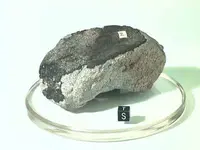Can you answer how the lunar feldspar differs from the earth? (Anorthositis from our planet)
Well, I
could, but the differences are largely of a nature that only an experienced geologist with access to the right equipment and with the benefit of petrological analysis would recognise. It would take most of a page to explain them to you in a more friendly manner than you could find for yourself by Googling for scientific articles.
In simple terms, someone with no such expertise wouldn’t be able to tell the difference, except for this:
Lunar anorthosites are light in colour. If you find anorthosite (assuming you have the ability to recognise it) which is dark in colour it will be terrestrial. However, terrestrial anorthosites can also be light in colour, so it’s not a definitive distinction but does enable some anorthosites to be excluded from having a lunar origin.
Terrestrial anorthosite cooled very slowly after its formation relative to lunar anorthosite. It therefore tends to have larger crystals… sometimes 25mm or more in length. Lunar Anorthosites will not have crystals of that size and are fine-grained with perhaps only a few crystals up to 10mm at most. Again it’s not definitive, as above, but enables some specimens to be ruled out as lunar.
The slow cooling rate for terrestrial anorthosite can cause some of the plagioclase crystals to exhibit an iridescent appearance as a result of optical interference created by a lamellar structure. It’s called ‘labradorescence’ and you will not see it in lunar specimens. Again, not definitive, except to rule out some specimens as having a lunar origin.
Without such knowledge, the only other criteria you can use are those which relate to meteorites in general… fusion crust and so on, plus the presence of accessory minerals which are not consistent with lunar origin. You won't find amphibole or garnet in lunar material for example, although they're often present in terrestrial anorthosite.





